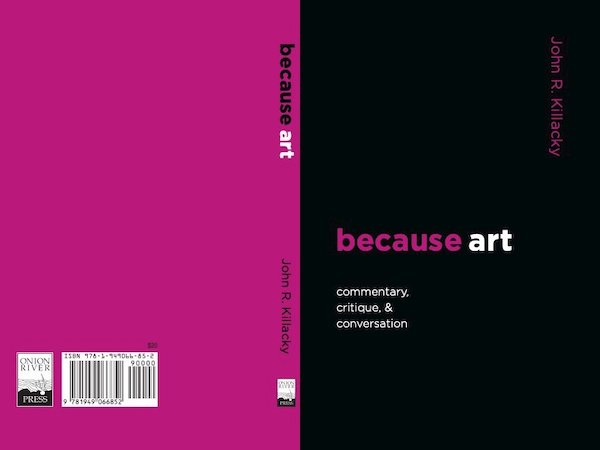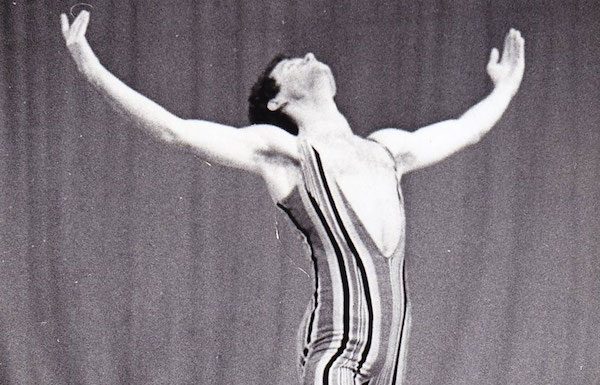Author Interview: Vermont’s John Killacky — At the Service of Art, Critique, and Civic Conversation
By Debra Cash
“I believe artists create a safe space for unsafe ideas in our world.”
because art: commentary, critique, & conversation by John R. Killacky, Onion River Press, Burlington VT, $20.
John Killacky has had a kaleidoscopic career.

Author, arts administrator, funder, performing arts curator, and gadfly John Killacky. Photo: Frédéric Silberman
He began as a postmodern dancer in Chicago and New York, and now finds himself legislating over issues including homelessness, substance abuse, and the role of the National Guard in the Vermont State House. In between, he has been an arts administrator, a funder, a performing arts curator, and always a gadfly. Throughout his geographical and occupational changes, Killacky has been a staunch believer that the arts are essential to our civic conversations. “I believe artists create a safe space for unsafe ideas in our world,” he writes. Now he has gathered “commentary, critique, & conversation” in a recently published volume of essay, speeches, reviews, and conversations he calls because art.
I first crossed paths with John in the early ’80s when he was executive director of the Laura Dean Company, whose dervish-spinning ensemble works were milestones in American minimalism. He went on to work for Trisha Brown at the juncture when her gorgeous, brainy abstractions became more theatrical and multidisciplinary, promoting her work to European impresarios, armed with a backpack full of press kits, a Eurail pass, and a list graciously shared by Art Becofsky, then executive director of the Merce Cunningham company.
At the Pew Charitable Trust in Philadelphia in the mid-’80s, he managed a $23 million arts fund. (As a point of comparison, this is less than the entire much-celebrated, post-Covid 2022 Massachusetts Cultural Council Budget.) Finding Pew’s outlook stultifyingly conservative (it has broadened its outlook since then), he says, “I really learned at that moment that bigger is not better.”
Killacky moved on to champion the transgressive and angry artists of the ’90s “culture wars” as performing arts curator at the Walker Arts Center in Minneapolis. He moved to San Francisco as executive director of the Yerba Buena Center, worked as a funder at San Francisco Foundation, and in 2010 came back East to Vermont to lead the Flynn Center for the Performing Arts in Burlington.
Not to mention the 16 short films, lots of presentations, and writing he produced at the same time.
Last month, we scheduled a leisurely catch-up on Zoom to discuss his new book. John and I had become better acquainted in 2016 when we spent three intense days together in New York during a landmark gathering of leaders in the dance and disability community. Yet in its scope and frankness, because art told me things about him I hadn’t known.
Officially, because art is an anthology of 30 years of written works and edited speeches. But read together, it is a series of meditations on the social role of art, the sometimes dysfunctional structures of the cultural sector, and the effect that unexpected, horrific loss — and the necessity of moving past it — can have on a person, a community, and the art created in response.
Killacky’s work has been shaped by two great public losses. The first was the AIDS pandemic. The second was his experience of unexpectedly becoming a quadriplegic after surgical complications to remove a tumor in his spine. The first made him angry. The second made him empathetic. Both made him an activist.
The AIDS pandemic — and the backlash to the work of artists who made art out of that suffering — coincided with Killacky’s time at the Walker.
“The AIDS pandemic: you and me, our generation lived through it. Younger people have no idea,” Killacky said.
“Our friends, our lovers, our families were dying. They were dying alone, they were dying in horrible conditions and it was important to give witness to that. In the book I include elegies I wrote for some of those seminal people who died and are no longer here — artists like Keith Haring and Peter Hujar and Reza Abdoh, who was the Artaud of our generation. [In those years] contemporary art meant it was political, it was about bodies, identity, anger, sadness around AIDS; it was a fiery, explosive, creative time, particularly in American culture.
“At the Walker, I found myself in the middle of the culture wars. It’s important for people to know how the conservative media tried to destroy artists like Karen Finley and Bill T. Jones. We think it’s all disinformation now, but Rush Limbaugh had a cable TV show and the truth didn’t matter.

“One time my mother called me up and said, ‘Oh my God what did you do? Rush Limbaugh was yelling about you last night that some artist had buckets of AIDS-tainted blood thrown at the audience.’ And I said, ‘Mom, that guy is a liar and a clown and it didn’t happen and he’s going for ratings. Who are you going to believe, him or your son?’ And my mother, who loved me very much, said ‘But it was on television!'”
“It was mind-blowing. I got a call that said ‘We got the abortion doctor, you’re next.’ Even though it could have been a foolish prank, the cops went around my house every half hour. And it was amazing to look out my window and think there could be someone sitting in their car and planning to shoot me. All for art that they didn’t see!”
Killacky had been at the Walker for eight years when his doctors found the tumor inside his spinal cord. He was supposed to be in the hospital for three days. Instead, he woke up paralyzed from the neck down.
“I was distraught,” Killacky said. “I lay in the bed and looked out the window and thought if I could get there — and I couldn’t, I was completely paralyzed — I wanted to break it and slit my throat. But once they sent me up to occupational therapy, the one finger had begun to move. They said ‘you can work on moving screws [to exercise fine motor coordination].’ I said I don’t think I want to do that. And then they said ‘well how about if we get you a computer?’”
In because art, Killacky describes his six weeks in rehab and also the remarkable process he took toward regaining partial mobility.
“How lucky I had been to have been a dancer! I had no sensation on my right side and no location, proprioception on my left. That’s permanent, even 25 years later. Many people with this are either shot or stabbed in the spine. A lot of them don’t live very long.
“But I said [to the rehab professionals] bring the mirror over: I think I can learn to stand up visually. Because that’s how I learned to dance.
“So it worked, Debra! I stood in front of the mirror with braces on both legs, and learned visually, not kinaesthetically, how to stand up. Then we set up parallel bars with the mirrors at the end and [I relearned to walk] with the bars underneath my armpits.”
Today, he walks with a cane and occasionally uses a wheelchair for longer saunters with his husband, Lawrence Connolly. He also hitches up a cart to his pony, Raindrop, a happy experience he compares to being able to dance and run again.

John Killacky in his days as a postmodern dancer.
The harrowing experience — and the ignorance of a rehab psychologist who should have known better — inspired him to collaborate with Bob Guter to write Queer Crips: Disabled Gay Men and Their Stories.
Later, Killacky’s work at the Flynn included a focus on improving its accessibility, not only architecturally but in ways that would welcome a range of artists and community members, including people on the autism spectrum.
Looking back, he believes “I was able to find my own artistic voice because of AIDS and disability.”
As we emerge from the current pandemic — or like those living with HIV, learn to adjust the new normal of dealing with a now-chronic but less threatening set of circumstances — Killacky sees this moment in culture as a time of radical reset and a time of making beauty out of constraints.
“I hearken back to the Grotowskies and Peter Brooks of the ’60s, who started with the bare stage and created things. This is the moment where we have to do the same thing. As a cultural community we have a blank slate. The restrictions are real. How do we make our work, how do we make political work, how do we make beautiful work during this time of deep pain, how do we make angry work again? In the ’90s there was a lot of angry work and I’m grateful that anger has come back into the art world.”
For five months a year, John Killacky concentrates on his day job.
“I announced my retirement from the Flynn in 2018 and [decided] the next part of my life is going to be all about service. At that point I got a call from my Vermont House of Representatives member Helen Head. I had campaigned for her.
“She said ‘I have an idea for your retirement. I’m going to be leaving the legislature and I think you’d be great.’ And in Vermont it’s a citizen legislature, which means we meet January through May. I’m in my second term.
“I had a talk recently with someone who is interested in running for office. He was telling me all his ideas, and it was all conceptual and high minded. You see the megalomania in politicians, the megalomania in philanthropy, where people think it’s their ideas and that they’re smarter than everyone else.
“But you have to understand the people you serve. It’s not about your career in politics, it’s about your service. Talk with restaurant owners, the small businesses, and figure out what’s really needed. Then maybe you can help with that.”
Debra Cash, a founding contributor to the Arts Fuse now serving on its board, is executive director of Boston Dance Alliance.

I cannot wait to read this. Soldiers in service, we salute you, John.
Thanks buddy
I am moved and inspired by John — just from this wonderful article — and cannot wait to read Because Art!
Thank you.